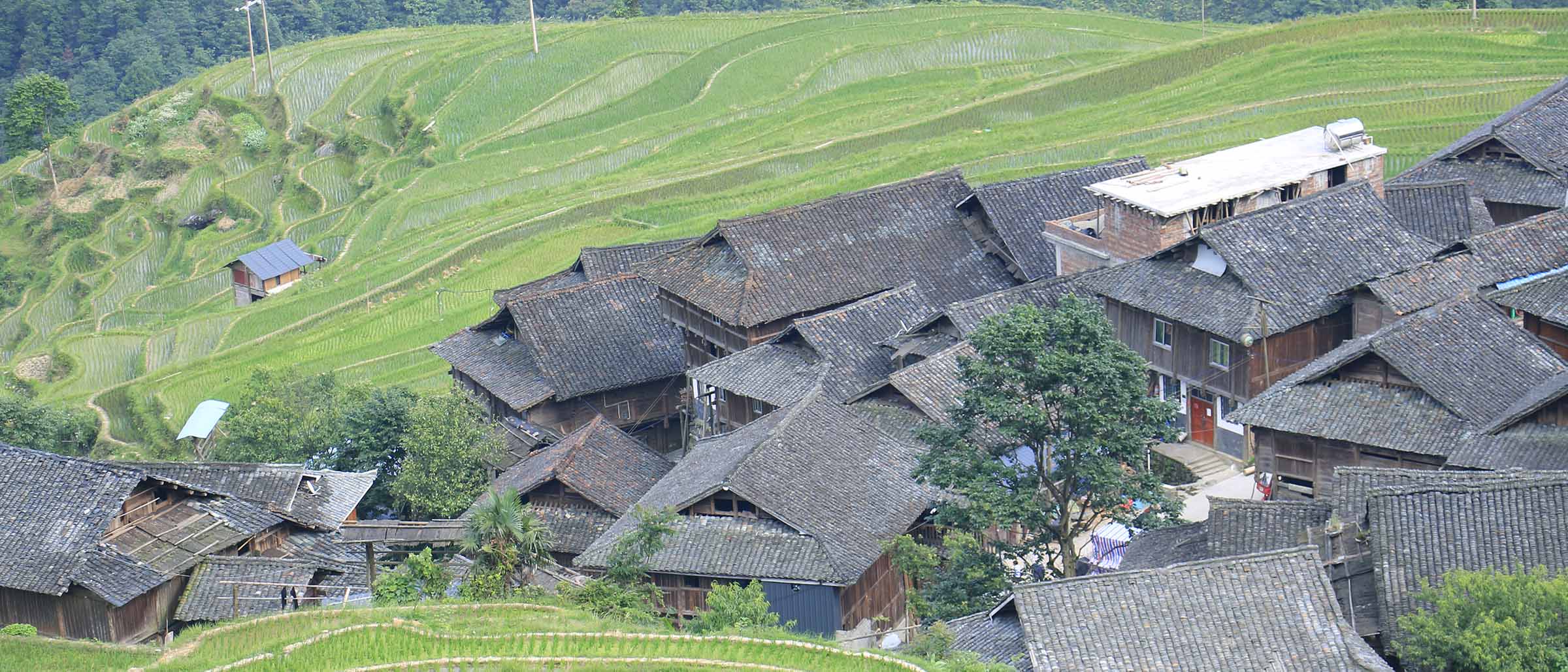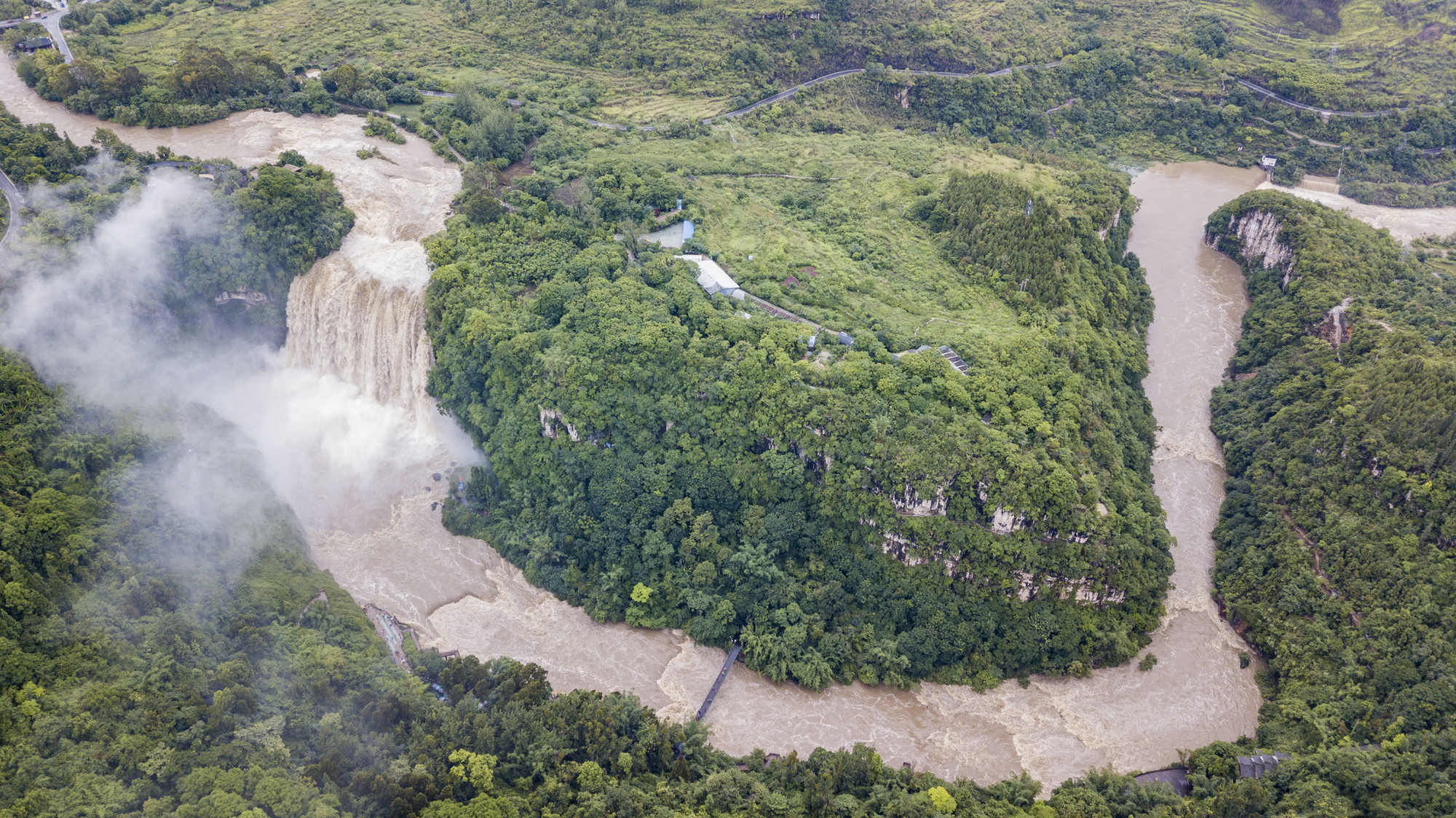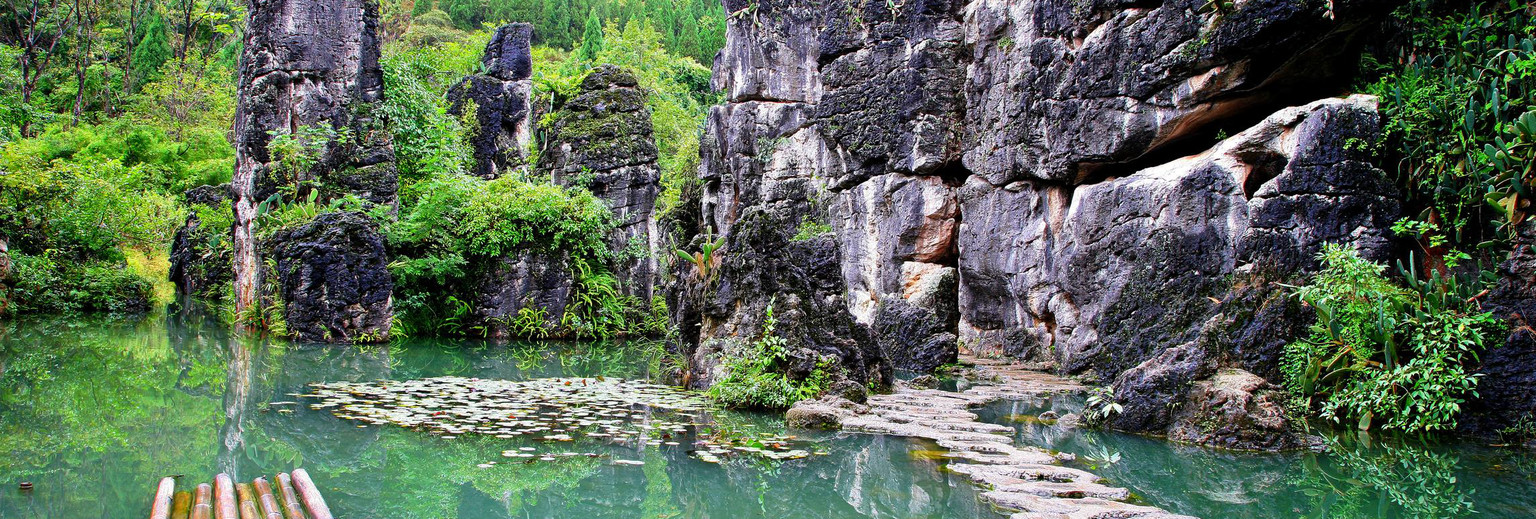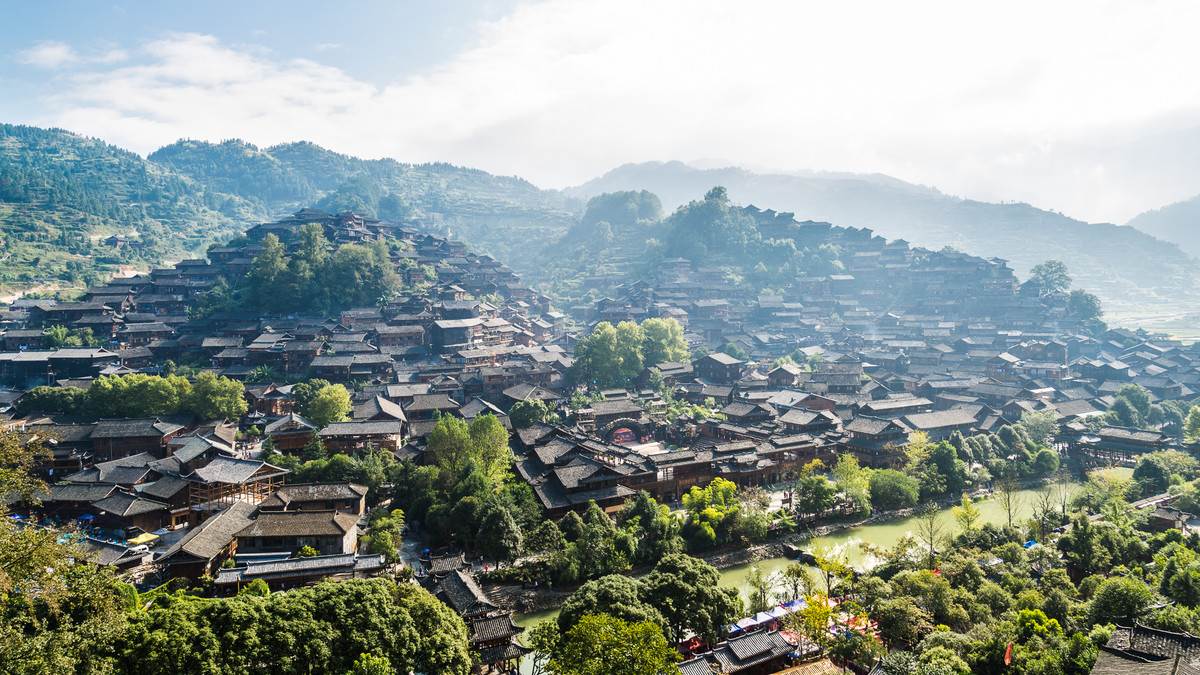- Guizhou -
Landlocked in the heart region of southwest China, Guizhou, or Precious Earth, has blown away visitors. The region, with an altitude of just over 1,000 meters, has no flat landscape. This is probably why ethnic minorities choose here as their home, thus, all traditions and customs are preserved, as the door of Guizhou development is closed.
With little fertile land, Guizhou is unfortunately among the poorest provinces in China. In fact, the per capita GNP is one-tenth of that of Shanghai; it is said more than 15% of the population of Guizhou live below the poverty line.
Yet when traveling in small villages in Guizhou, there are smiling faces greeting you throughout your time. The people enjoy meeting people from different cultures, some of the 18 minorities in the province sometimes take out their ceremonial costumes for the occasion. Accounting for about 3% of the population of Guizhou, these ethnic groups live hard on products provided by the surrounding land. The minorities of Miao, Dong, Bouyi, Yi, Shui, Hui, Zhuang, Gejia and many others offer an overview of their characteristics: architecture, language, customs, clothing, food and festivities are especially authentic.
Guizhou is also known for the various festivals organized by ethnic groups throughout the year. When you visit Guizhou, you would experience the local festivals more often than not.

Basic Information
Chinese Name: 贵州(Gui Zhou)
Provicial Capital: Guiyang
Location: Guizhou borders the autonomous region of Guangxi to the south, Yunnan to the west, Sichuan to the northwest, the municipality of Chongqing to the north, and Hunan to the east.
Climate: subtropical humid monsoon climate
Area: 176,167km²
Population: 358,000,00(2018)
Major Ethnic Groups: Miao, Dong, Yi, Tujia, Buyi
Famous city: Guiyang, Chishui, Zunyi, Anshun, Kaili
Guizhou Geography
Guizhou is situated in the eastern part of the Yunnan-Guizhou Plateau in southwest China. In this land of towering mountains and deep valleys, there are over 300 basins which are wide in the middle and narrow at both ends. The average annual temperature is between 14°C and 16°C Eighty percent of Guizhou is mountainous. The plateau is intersected with mountains, hills, basins and valleys, giving it a very rugged, erosion formed topography. In many areas underground streams have carved the limestone into fantastic caverns.
The area north of the Miaoling mountain range is drained by the Yangtze River, whose larger tributaries are the Wujiang, Chishui and Qingshui rivers. South of the range is the Zhujiang valley, where there are Huangguoshu Waterfall – Guizhou Travel Guidethe Nanpan and Beipan rivers, both headstreams of the Xijiang River. The spectacular Huangguoshu Waterfall at the head waters of the Dabang River is Asia’s highest waterfall. The largest lake in Guizhou is Caohai.
Guizhou Cuisine
The climate in Guizhou is subtropical and humid, meaning it benefits from mild winters and comfortable summers, although the province is frequently plagued by heavy monsoons. The average temperature is roughly 10 to 20 °C, with lows of around 1 °C in January and highs of is around 28 °C in July. There is about 406 mm of rain in a year. It is dry for 218 days a year with an average humidity of 69% and an UV-index of 5.
Its seasons tend to merge with neither severe winter nor hot summer. This moderate climate is due to the high mountains and lush vegetation in the area, which wards off the intense summer heat and severe winter cold. The agreeable weather makes it suitable for travelers to visit Guizhou all year round. However, Guizhou has more overcast days and rainfall than any other part of the country. Influenced by this regions' diverse topography, the climate can be very diverse, which is well described by two local sayings: "Different weather five kilometers apart." and "Four seasons in one day".
Guizhou Climate
The cuisine of Guizhou, known as Qian cuisine is one of China's eight famous cuisines. It is called Qian cuisine because Qian is the Chinese short name for Guizhou Province. Guizhou cuisine is spicy like Sichuan Cuisine, but that is where the similarities end. The cuisine in Guizhou is sour and spicy, making it unique amongst China's cuisine styles. The locals love their Guizhou cuisine and cannot bear to go even a day without eating it. There is an ancient local saying which states "Without eating a sour dish for three days, people will stagger with weak legs". This gives a fairly good idea of their love for their local cuisine. For visitors to Guizhou, great places to pick up local snacks and food are the Hequen Road near River Park and the Shaanxi Road near the spray pond.
Guizhou Flora and Fauna
Guizhou Province boasts a plethora of flora and fauna. There are more than 3800 varieties of wild plants in the province, of which the thorny pear and the Chinese gooseberry are high in vitamin C, the agarics and other comestible mushrooms are high in protein, and the Chinese sumac is host to numerous plant galls that are rich in resins and tannic acid, which are used in the manufacture of ink, dyes, and ointments, much of which is exported. More galls are found on the plants of Guizhou Province, per square meter of area, than in any other province in China.
Medicinal plants in Guizhou Province total some 3700 varieties, accounting for 80% of the nation's total. The most famous such plants are duzhong , tianma , zhuyu, shihu, and huanglian. There are 70 varieties of rare and precious plants in Guizhou Province, of which the silver China fir, the dove tree, the bare China fir and the spindle tree fir all are under the strictest of state protection.
In addition, there are over 1000 different species of wild animals roaming freely in Guizhou Province, 83 of which belong to an endangered-species class that enjoys state protection, including the golden monkey, the black-leaf monkey, the south-China tiger and the black-neck crane.
Guizhou Tourism
Guizhou tourism resource is made up of natural landscapes, climate species, lakes, mountains and rivers, ethnic customs, sacred sites and social development.Here, mountains, water, caves, forests and stones, all blend into one harmonious whole. World-renowned Huangguoshu Waterfall, Dragon Palace Cave Scenic Area, Chishui Danxia Landform, Zhijin Cave, Qianling Park, Qingyan Ancient Town and other scenic spots are like a string of colorful gems, making tourists unforgettable.
Guizhou is charming "natural park". Its domestic natural scenery is beautiful and magic; its scenery appearance is in thousands of postures; its karst cave landscape is colorful; its wild animals is wonderful infinitely.
Here, mountains, water, holes, forests, stones enhance each other's beauty, one integrated mass. The world famous Huangguoshu Waterfall, Dragon Palace, Chishui, Zhijin Cave, Qianling Park, etc. scenic areas are like a string of bright and colorful precious stones, making tourists too many things to see and reluctant to leave.
Its multiple national long and splendid history and culture, rich and mysterious national amorous feelings, and pleasant climate, making Guizhou become an ideal tourist sightseeing and summer resort.The southeastern corner of the province is known for its unique Dong minority culture. Towns such as Rongjiang, Liping, Diping and Zhaoxing are scattered amongst the hills along the border with Guangxi. It is rich in various minority villages, such as the Zhaoxing Dong Village and Basha Miao Village.It has many covered bridges, called Wind and Rain Bridges. These were built by the Dong minority people.
The rich population of minorities in Guizhou allow for a great many ethnic festivals throughout the lunar calendar. During the first lunar month (usually February), the early festival in Kaili (east of Guiyang) celebrates local culture with acts of bullfighting, horse racing, pipe playing, and comedy works.
Folk Festivals
Guizhou plays host to hundreds of festivals every year. Guizhou people live a simple life, but they, in particular the Miao and Dong, always seem to have something to celebrate. Thus if you plan to visit Guizhou, you should make sure to hit at least one of the traditional festivals. A good starting place for festival glance is Kaili, a profusion of festivals is held in nearby villages. Some of the larger and more popular annual festivals include the Lusheng Festival, Dragon Boat Festival and Sister's Meal Festival. And these festivals are held on auspicious lunar dates and therefore vary from year to year in Roman calendar.
Bullfight Festival
The Miao and Dong people in Southeast Guizhou like to hold the "Bullfight" competitions in spring and autumn. Bulls used for fighting are specially raised and are entitled "king bulls" or "holy bulls".
During the festival, families and villages around the bullfight ground prepare feasts to entertain the coming guests and welcome the "holy bulls" from different places. Some bulls for fight are decorated with iron horns, covered with red satin,with pheasant tail on the back and bronze bells on the neck. Some bulls are decorated with big silk balls, colorful ribbons and bronze bells on the waist, and with a tiger tail. They look like generals ready to go out to battle. The entrance ceremony of the bullfight is called "stepping ground".
In recent years, during Kaili international Lusheng Festival, over on hundred buffaloes participate in the competition, with huge crowds of people watching by. The grand spectacle is bustling with noise and excitement and with a deafening sound of gongs and drums.
Sisters Meals Festival
The Sisters’ Meal Festival or the Sisters’ Rice Festival, originated from the Miao minority group.During the Sisters’ Meal Festival in the third lunar month in Shidong, Taijiang County in Southeast Guizhou Province, girls rush to the mountains to collect wild flowers and berries to dye glutinous rice known as Sister’s Rice. Everyone then starts cooking their respective special meals that are composed of glutinous rice dyed in several colors to form rice balls. Each girl prepares her rice with a symbol and then wraps it in a handkerchief or put it inside small baskets.
On that day, Miao girls give four-color rice to the man they love as a present. It is considered the oldest "Valentine's Day" of China.
Lusheng festival
Lusheng Festival is the grandest festival in the Miao and Dong ethnic areas of Guizhou province. It is held once a year from the 27th day to the 29th day of the 9th Chinese month. People from the cities and villages nearby get together to celebrate the good harvest and to greet the New Year. Lusheng is a reed-pipe wind instrument that is popular in the Miao, Yao and Dong ethnic minorities of Southwest China.
Miao's New year
The Miao's New year is a tranditional festival to offer sacrifices to the Miao's ancestors and to celebrate a bumper harvest in October in Qiandongnan Miao areas. It is usually celebrated three times -- the "Big year", the "Small Year" and the "Tail year", of which the Big Year is the most popular one, in which gatherings are held, lasting three to five days, or more than 10 days in some other areas.
The marriage celebration and house-building of the Miao people are often carried out inOctober when autumn harvest is finished and farmers are free, this adding the joyful atmosphere to the Miao's New year. In recent years many sports such as bullfight, horse race, basketball match, chess-playing contest are held during the festival, making the old festival take on a new look.
Huangguoshu Waterfalls scenic Area
Chinese name: 黄果树瀑布(Huang Guo Shu Pu Bu)
Location: Anshun county, Guizhou Province. (about 140km from Guiyang)
Ticket: Entrance ticket CNY160.00 during 01Mar to 30Nov, CNY150.00 during 01Dec to 28Feb; sightseeing bus CNY50.00, Round-trip Grand Escalator CNY50.00 (Entrance ticket include Tianxing Bridge and Doupotang waterfall)
Estimated tour time: 3-5 hours
Recommended time to visit: May to Oct
Nearby attractions: Dragon Palace, Malinghe Grand Canyon, Tianlongtun Pu.

Located in west Guizhou, Huangguoshu National Park of China is 128 km from Guiyang and 45 km from Anshun, a tourist destination in West China. The park istraversed with Yunnan-Guizhou railway, Zhuzhou-Liupanshui II Track Railway, National Road #320, and Guiyang-Huangguoshu High Grade Road, etc and encompasses the Huangguoshu Airport and the newly-built Qingzhen-Huangguoshu Freeway. The park centers at Huangguoshu Waterfall (height: 77.8m, width: 101.0m) and is scatted with 18 waterfalls of varied sizes, some precipitous and majestic, others picturesque and fantastic. All the waterfalls form a great “family”, which is ranked as the largest in the world in the Guinness Book of World Records. The giant Huangguoshu Waterfall is the most magnificent member in the family and the only waterfall that can be viewed from above, below, front, back, left and right in the world. It is also with a water curtain cave in the back through which tourists can hear, view, and touch the waterfall. The great Ming traveler Xu Xiake, when investigating the waterfall, remarked, “the sprays burst apart like pearls and jades and the foams rise like a mist. The waterfall is with such a momentum that even the couplet ‘a screen of pearl released from hooks/or silk that hangs on faraway peaks’ cannot describe to the full its majesty. I have seen waterfalls that are much higher and more precipitous, but never a waterfall with such a width and magnificent.”

Centering at Huangguoshu Waterfall Resort, the Huangguoshu National Park of China encompasses such resorts as Stone Village, Tianxing Bridge, Dripping Shoal, Balinghe River Valley with the site of the ancient post path, Doupotang, and langgong, etc. It isamong the first batch of national key scenic spots and of AAAA resorts ranked by the government. The resort has been successively designated as the national popular science education base, “National ”, and “Most Charming Tourist Resort in West China”. In 2005, it was ranked as the “most beautiful place in China” by Chinese National Geography, “10 Tourist Resorts of Customer Satisfaction in China” by People’s Daily, and “10 European Tourists’ Favorite Resorts in China”, etc.
Huangguoshu Tourist Resort features beautiful natural environment, refreshing air (with over 28,000 negative oxygen ions per cubic centimeter according to the statistics of the provincial environmental protection department), a pleasant climate (with the annual average temperature at 16ºC), long historical and cultural tradition, and complete supporting facilities. It is an ideal resort for amusement, rehabilitation, sightseeing, and “lung-washing”.
Tianxing Resort
Tianxing Resort is a fully developed zone in Huangguoshu National Park. The planned area of the resort is 7 square km and the developed area for tourism is 4.5 square km, which is divided into 3 interconnected parts, namely, Tianxingpen Resort, Tianxingdong Resort, and Waterborne Stone Forest Zone. The resort is integrated with mountains, waters, forests and caves, featuring dense stalagmites, lush forests, and limpid water.
Located on the surface of a 500-m-long underground stream west to the river bank, the Tianxingpen Resort is about 800 meters long with natural rock formations of various sizes. A 3-km-long stone-planked path winds through the stone walls, moats, and openings and above the rock formations. Wandering in the resort, you can appreciate the natural beauty of the mountains and the hills and the majesty of the stone forest. The stone forest nearby and the remote peaks are reflected in the dark green water, unfolding a light, elegant, pleasant landscape. You can also take a bamboo raft, float in between the valleys and the stone forest, and enjoy the natural scenery from another perspective.
Tianxingpen Resort has also such natural scenic spots as Beauty Banyan, Celestial Palms, Slanting Comb, Panda Holding Bamboos, and Wing-Spreading Hawk, etc. Tianxingdong Resort is located in the middle of Tianxing resort. Besides the stalactites in the cave, the scenic spot has also a special sight outside the cave: the sight called “a gleam of sky” has a very narrow path that is over 20 meters long; Maoshuitan Pond is the outlet of an underground river. When there is a flood, the river under the heavy impact can rise as high as 5 to 6 meters high, which forms a majestic scene.
The river bed in the Waterborne Stone Forest zone is as wide as 400 meters, in the midst of which the stone forest stands, covering an area of about 0.4 square km. The forest is washed by the river for years, which is scattered with large patches of cactus and shrubs and shaded under the green trees. On the cold stones is a scene of the prosperity of life. As the saying goes, “the water runs over the stones, and the stones crouch over the water. There are stones over stones with trees growing on top of them.” The Waterborne Stone Forest zone boasts of many scenic spots, such as Banyan Party, Root King, Root Screen, Winding Roots and Picturesque Wall, Celestial Lady, etc. The Galaxy Waterfall and the Xingxia Waterfall are also located on the left and right sides of the stone forest.

Doupotang Waterfall
Located 1 km from the upper reaches of Huangguoshu Waterfall, Doupotang Waterfall is 105 meters wide in the top and 21 meters high. It is the widest in the top among all the waterfalls in the park. On the top of the waterfall is a large water-eroded pool covering an area of 15,000 square meters, and the waterfall is formed on the calcified bay that is over 100 meters long. There is another special phenomenon in the scenic spot, that is, the waterfall will produce a rumbling noise every year before the flood comes, hence the name “roaring waterfall”.
“Upon hearing the rumbling noise of the waterfall, I looked northward from between the mountains and saw suddenly a river dashing from the northeastern peaks along the cliff and pounding into the deep pond below. The upper part of the waterfall is dozens of meters wide misted with foams and sprays, while the lower one I could not see, for the cliffs on the opposite obstructed my view.” This is the description of Doupotang Waterfall in Xu Xiake’s Travelog by the famous traveler.
In 2005, Doupotang Waterfall was added with fishing and bird-viewing (of peacocks) facilities, etc, and the “Phoenix Garden” was built into the resort zone featuring numerous beautiful flowers and birds.


- $1138.00
- 8D7N DAYS
01. Enjoy Luoping County from its most colorful side and make beautiful pictures, the dozens of thousands of rape flower fields was awarded the title of "the world's largest natural Garden (rape plantations)" by the headquarter…
Read More
- $958.00
- 7D6N DAYS
01. Experience the original merchant lifestyle, visit master craftsmen, see superb handwork skills, and gain an in-depth understanding of the ethnic minorities’ cultures in Xijiang Miao Village.02. Appreciating different views of the waterf…
Read More